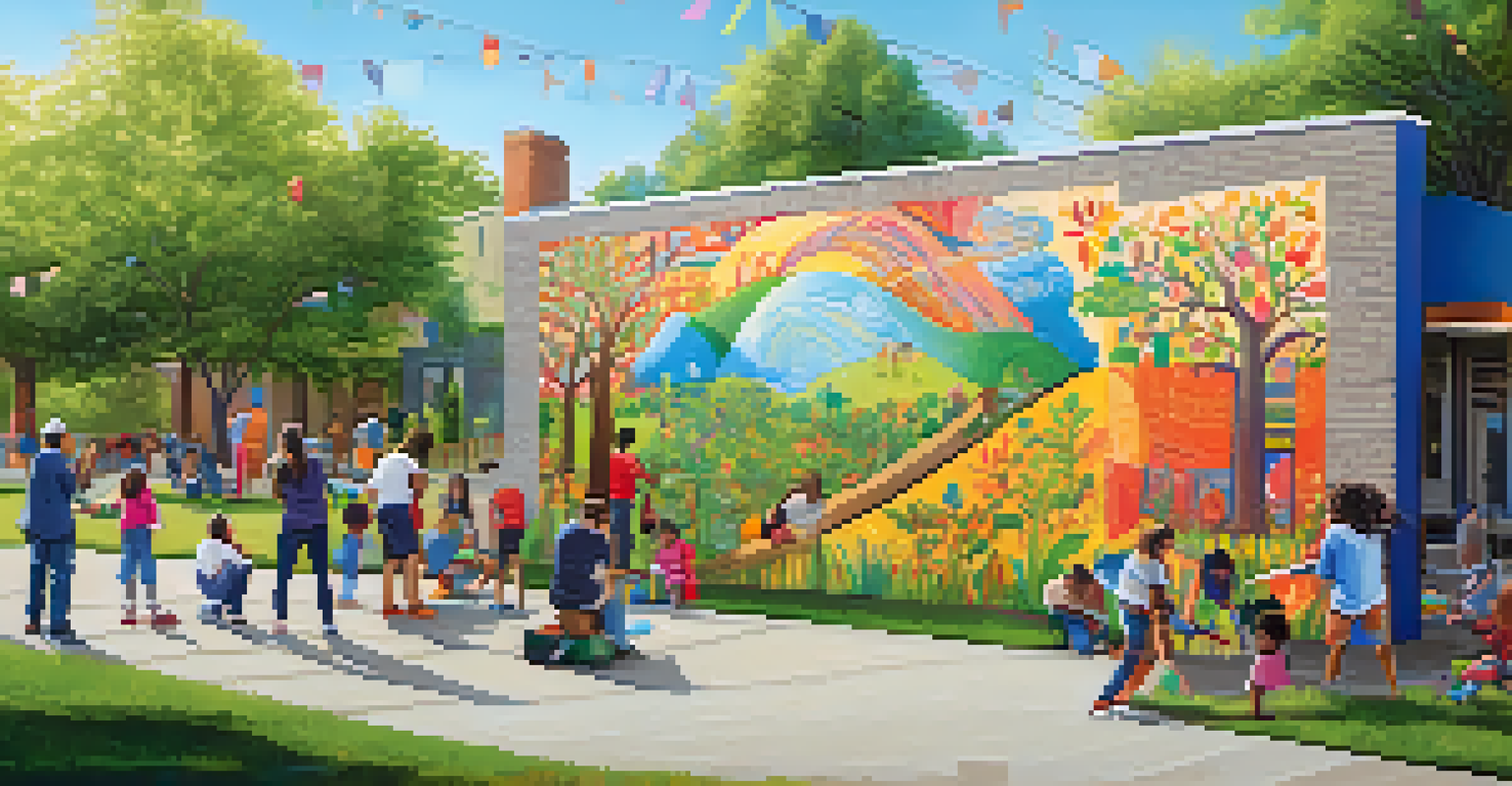The Role of Murals in Enhancing Urban Aesthetics and Unity

Murals as a Reflection of Local Culture and Identity
Murals often serve as a vibrant canvas reflecting the unique culture of a neighborhood. They encapsulate local stories, traditions, and the diverse backgrounds of the residents. For instance, a mural depicting historical figures or events can instill a sense of pride and belonging among community members.
Art is not a mirror held up to reality, but a hammer with which to shape it.
Beyond mere decoration, these pieces of art become symbols of local identity, making areas instantly recognizable. They can evoke nostalgia or spark curiosity, drawing both residents and visitors into a richer understanding of the place. In this way, murals act as cultural touchstones that resonate deeply with the community's heritage.
Moreover, murals can foster a sense of unity among residents by celebrating shared values and experiences. When people see their stories depicted on walls, it creates a common ground that can break down barriers and encourage dialogue. This shared appreciation for art can lead to stronger community bonds.
Transforming Urban Spaces into Vibrant Destinations
The presence of murals can drastically change the perception of urban environments. What were once dull or neglected walls can become lively focal points that attract attention and foot traffic. This transformation can turn a simple alleyway into a bustling art district, inviting people to explore and enjoy their surroundings.

For example, cities like Philadelphia and Berlin have embraced murals as essential components of their urban landscape, turning them into tourist attractions. Visitors often seek out specific murals, making these areas hotspots for both locals and tourists. This not only enhances the aesthetic appeal but also boosts local businesses.
Murals Reflect Local Culture
Murals serve as vibrant canvases that encapsulate the unique stories, traditions, and identities of a neighborhood.
In essence, murals can redefine the way we experience our cities. They provide a sense of place, encouraging people to linger and appreciate the art, which can lead to a more engaged and active community. The vibrant colors and dynamic designs breathe new life into urban spaces, creating memorable experiences.
Murals as Tools for Social Change and Awareness
Many murals go beyond beautification; they often carry powerful messages about social issues. Artists use their work to raise awareness about topics like climate change, social justice, and community struggles. These murals can provoke thought and inspire action within the community.
Public art is a way of enhancing the quality of life in a community, creating a sense of place and identity.
For instance, a mural depicting the effects of pollution can encourage viewers to consider their environmental impact. By presenting these important themes through art, murals can engage a wider audience in discussions that might otherwise be overlooked. This intersection of art and activism can be a catalyst for social change.
Moreover, when communities collaborate on these projects, it fosters a sense of ownership and responsibility. Residents feel empowered to express their concerns and aspirations, leading to initiatives that address local issues. Thus, murals become not just art but also a platform for community dialogue and transformation.
Community Engagement Through Collaborative Mural Projects
Collaborative mural projects offer a unique opportunity for community members to come together and contribute to their environment. Often, these projects invite locals to participate in the design and painting process, fostering a sense of pride and ownership. This engagement can strengthen community ties and create lasting memories.
For example, a neighborhood may organize a mural event where residents share their ideas and collaborate on the artwork. This process not only allows for diverse voices to be heard but also encourages teamwork and creativity. Participants often form new friendships and connections, enhancing the community spirit.
Economic Boost from Murals
Murals can attract tourists and increase foot traffic, benefiting local businesses and potentially raising property values.
These projects exemplify the power of art to unite people and celebrate diversity. By working together on a mural, individuals from different backgrounds can find common ground, transforming the act of painting into a shared experience that strengthens community bonds. The finished mural then stands as a testament to their collective effort and creativity.
The Economic Benefits of Murals in Urban Areas
Beyond their aesthetic and social contributions, murals can also have significant economic impacts on urban areas. They can attract tourists and art enthusiasts, boosting local businesses and contributing to the economy. A well-placed mural can increase foot traffic, leading to increased sales for nearby shops and restaurants.
In some cases, cities have even seen property values rise in areas with prominent murals. The presence of art can enhance the appeal of a neighborhood, making it a desirable location for both residents and investors. This phenomenon highlights how art can be an integral part of urban development strategies.
Moreover, local governments and organizations can capitalize on this trend by investing in mural projects. By supporting artists and promoting public art initiatives, they can stimulate economic growth while improving community aesthetics. It's a win-win situation that illustrates the multifaceted benefits of murals in urban settings.
Murals and the Psychological Impact on Communities
Murals can significantly influence the psychological well-being of a community. Bright, colorful artwork can uplift spirits and create a positive atmosphere, transforming how people perceive their environment. This can lead to a sense of joy and belonging among residents, fostering a more vibrant community life.
Research has shown that exposure to art can reduce stress and anxiety levels. When people interact with murals, whether by admiring them or participating in their creation, they often experience an increase in happiness. This emotional connection can enhance community pride and foster a greater appreciation for local culture.
Community Engagement Through Art
Collaborative mural projects foster community ties and pride by allowing residents to participate in the creative process.
Additionally, murals can provide a creative outlet for self-expression, allowing individuals to share their stories and experiences. This sense of agency can empower residents, encouraging them to take an active role in shaping their environment. Ultimately, murals contribute to a healthier, more connected community.
Preserving Murals and Their Cultural Significance
As urban spaces evolve, the preservation of murals becomes crucial for maintaining their cultural significance. Many murals tell important stories and represent the history of a community, making their protection essential. Efforts to preserve these artworks can help ensure that future generations appreciate and learn from their heritage.
Community engagement is key in the preservation process. Involving local residents in maintenance and restoration efforts fosters a sense of responsibility and pride. This collective commitment can lead to initiatives that protect and celebrate the murals, ensuring their longevity.

Moreover, as cities continue to develop, integrating new murals with existing ones can create a dynamic and evolving narrative. This balance between preservation and innovation allows communities to honor their past while embracing their future, ensuring that murals remain a vital part of urban life.